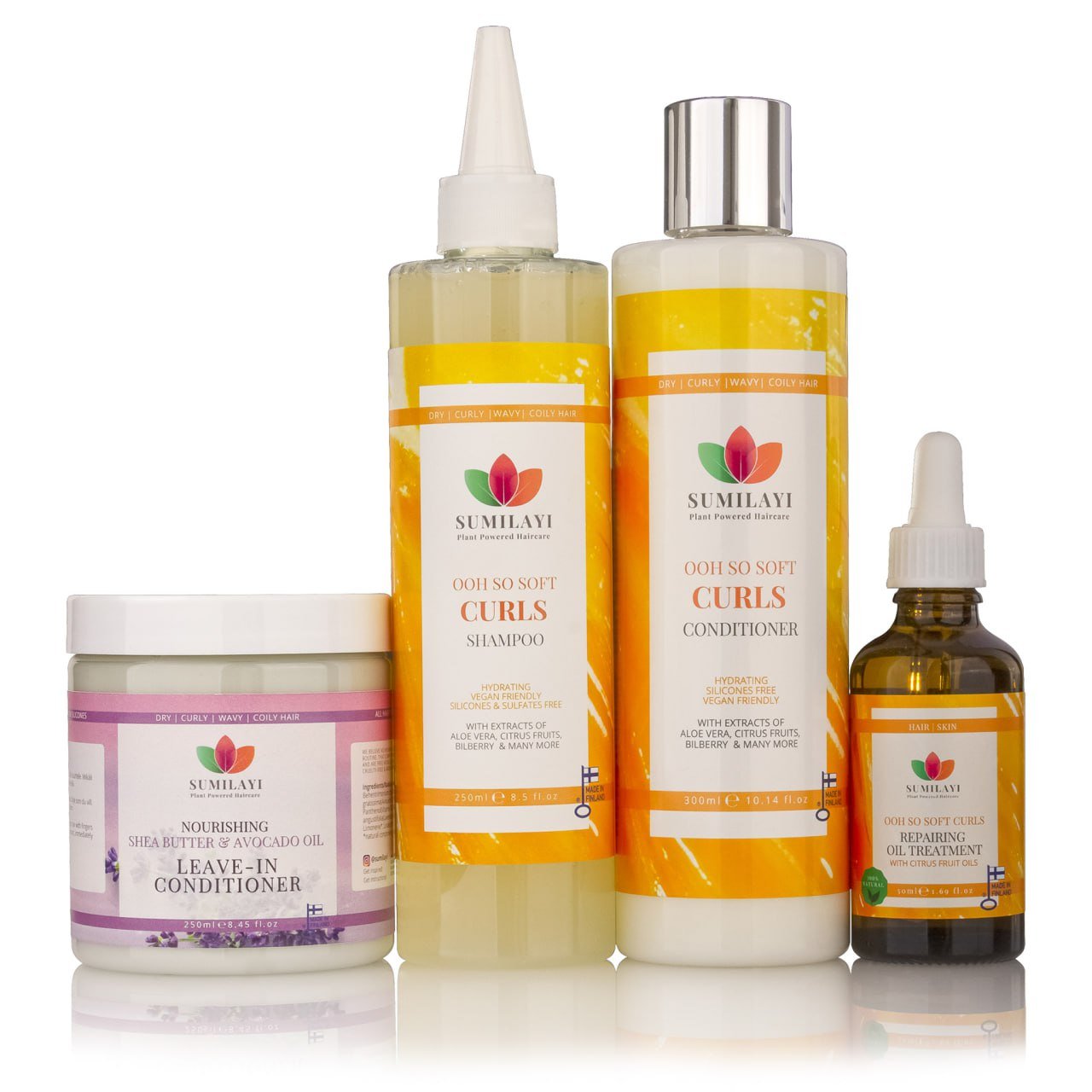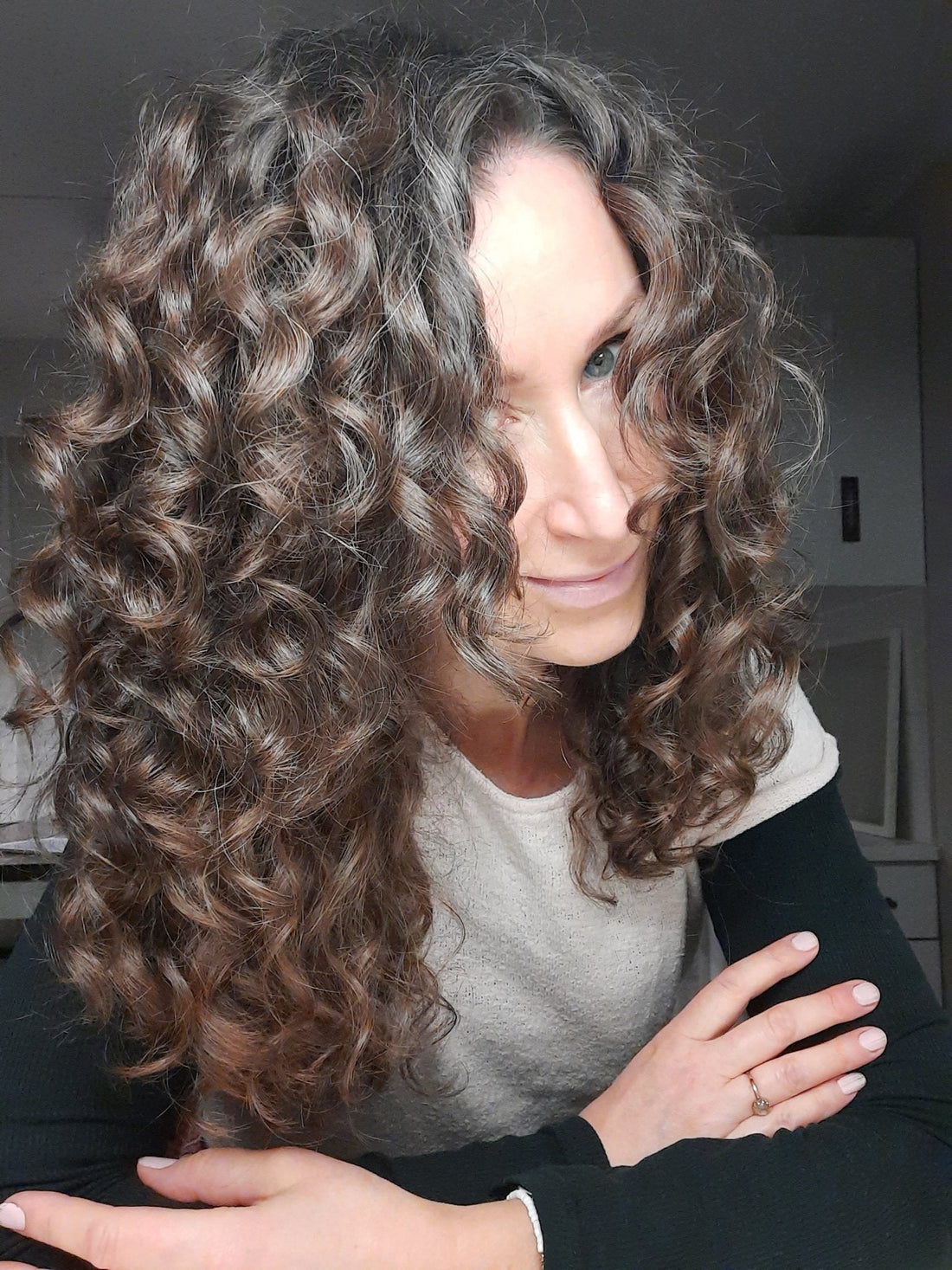Mariia blogs on Sumilayi's blog about curly hair methods, care, products and experiences, sharing her best tips.
The Curly girl journey probably starts most often full of enthusiasm and anticipation on the one hand and confused by everything new on the other hand. Completely understandable! The way you've been taking care of your hair up until now with the method may turn out to be completely inappropriate, and you can feel it in your naturally bent or curly hair, and that's why the method may have attracted you.I remember in the time before my curly journey how from time to time I wondered why one moment my hair seemed even tolerable in some way and the next moment completely creepy. After I started the method, I found out the reason was that sometimes I had gotten a shampoo and/or conditioner that was more suitable for my hair type and I felt - without knowing the reason - for a short moment what I would normally experience with the method.
For me, my initial journey into the world of new habits was, as I have said, quite effortless. I did read a lot of things related to the method here and there, but I also questioned how my hair felt after certain procedures and not so much how someone else's hair felt or looked. Afterwards, I thanked myself for having the courage to trust my own feelings and move forward that way.
Even if the idea is that it's so easy to get the products and adopt routines for your hair just by imitating someone else's habits and products, such an income angle easily ends in disappointment or banging your head against the wall for an unnecessarily long time.
On the other hand, if from the beginning you strive - as funny as it sounds - to create a relationship with your OWN hair, it will be much easier in the long run.

Pictures: I have moments of pain on my own journey when I have used products and habits that are not suitable for my porosity. The curls don't stay, they feel dry and brittle and they frizz easily.
One significant thing in this detective-like (it can feel like it at times!) hair mystery is the porosity of the hair. Knowing the porosity and knowing how hair with different porosity behaves has a big impact.
Porosity means the hair's ability to absorb and retain moisture.
Hair can be
- Low porosity
- High porosity
- Something in between, clearly neither, i.e. you can also say normal or medium pore
- A combination of low and high porosity
Do you already know the porosity of your own hair? Has it changed along your curling journey?
I had low porosity hair at first, then it got to the middle stages, but due to using the wrong products, I got confused for a while and even thought my hair was high porosity. At the moment, I'd say I'm more where I started, i.e. on a low slope. I'll discuss porosities and how to identify them below.
Hair is scaly when viewed under a microscope. The scales can either be very tightly closed, so the hair feels very smooth between the fingers. The scales can also be open, which again makes the hair feel jagged/rougher between the fingers.When hair is highly porous, it:
- Easily absorbs water and products
- Reacts to damp weather by fluffing up
- Easily drains water and products from itself
- Can get tangled easily
- May branch from the top
- Needs more e.g. proteins/repair products
- Can withstand heavier products
- Has been treated often (lightening, straightening iron, etc.)
- Benefits from rinsing with cooler water
- Dries quickly
- Can look dull
- Can withstand heavier (e.g. creamy, oily) products unless very thin
- Build-up, i.e. product residues, does not easily accumulate on the surface
- Easy to dye but the color can fade quickly
- Slowly absorbs water and products
- Does not fluff easily when wet
- Holds moisture and products well
- Is smooth and not branched
- Is usually shiny
- Sensitive to proteins
- Sensitive to heavy products
- It is often untreated and especially unbleached
- Benefits from warm/lukewarm water when rinsing
- Benefits from e.g. deep treatments done in warm weather
- Dries slowly
- Might like a mild shampoo wash more than a conditioner wash
- It can be challenging to dye, but the color stays well
- Sensitive to build-up, i.e. the layering of products on the surface
- It is quite easy to care for, i.e. it absorbs water and products well and keeps the moisture inside, it does not require any other measures but is grateful for even care and moisturizing, and it is quite easy to dye
It may be that while reading the above you think at one moment that you clearly have the same hair as in the description you read and when you move to the next descriptions of different porosity, it may be that you find your own hair on the list again. So it's not always easy to determine what you can find on your own head, but of course it's all the more rewarding in terms of future washing days when you really start to understand the soul life of your hair.

Photos: More fluff! At one point, I believed that my hair was indeed highly porous and I started treating it that way. However, it was an ingredient that didn't work in my hair, and the wrong actions then added to the pain.
All learning takes time, so try to keep your nerve along the way. Before long, you'll begin to gain insights into your hair.
There are several different ways to help you determine porosity.
You can:
- Spray water on the surface of your dry hair and if the water remains beaded on the surface of the hair, your hair is low porosity and if the water is quickly absorbed into the hair, it is high porosity
- Find a few hairs (= naturally detached) from your brush and put one at a time in a glass of water. Wait a couple of minutes. Low porosity remains on the surface and high porosity sinks. If the hair does both, find out at which end (root, top) each porosity is. (Between your fingers, you will feel a knot on the base side, the cap of the capillary that goes with it when the hair comes off)
- Try sliding the hair between your fingers from the bottom up. If you feel the hair, it is probably high porosity and if it feels smooth, it is low porosity
The challenge in testing is that hair with, for example, product residues can behave completely differently when tested than completely clean hair, or the fact that your head can have many types of porosity mixed up, for example if the base is new growth (low porosity) and the lengths/tops have a lot of bleaching, using hot or damage caused by others (high porosity). That's why you might not be able to pass easily even with the help of tests.

Keeping a hair diary can make things easier, for example. Record washing days and other information; what products you used, was the rinse water cold or hot, did you wash in the sauna, how did the hair dry (on its own, with the dryer), how long did it take to dry and how did the result feel on the same day and the following days, was there any need to do any procedures in the days in between.
In this way, there are at least better chances to quickly start to find out what works and what doesn't and make porosity conclusions based on that, making it easier to give the hair what it needs.


Pictures: My own hair in glass. As you can see, they stay firmly on the surface of the glass and do not sink the entire time they are there. Low porosity is indicated by this test.
Once you've found out your porosity and whether, for example, the ends and lengths are of the same "quality", you can then take measures taking the porosity into account, for example changing the warm rinse water to cool or reducing the use of protein-rich products, adding thicker, more nutritious products, avoiding hasty washing, or what about your own hair this understanding also brings.
In my case, the fact that, except for several months of complete product confusion and a few shorter side streaks, I have studied the behavior of low porosity and tried to do things with that in mind has brought great ease to the care of my curls. I'm also really happy that my hair is just low porosity because even though it can cause a headache (literally!) I feel like it suits my lazy style of taking care of my hair really well 😄😄
Since my hair doesn't frizz very easily and doesn't get tangled, I get - often by accident and without planning - an extended washing interval and I can, for example, sauna with a pop shirt on and continue for the next couple of days just fine without doing anything to my hair.
I think I wrote about this topic on Instagram recently, unfortunately it backfires in the way that I have to wash my hair with shampoo (low-poo) which doesn't work at all on my hair at the moment because I haven't found a product that is of sufficient quality, protein-free, coconut-free and aloe vera-free! All of the above-mentioned things make my hair go crazy 😅 (fortunately, only for a while when I find the culprit and go back to my normal products)

Picture: here's a wonderful balance! The hair is shiny, soft but supple, not frizzy and keeps its shape well.
So my advice to you is; if your hair feels strange, of course you can continue what you are doing, hair is dead matter and in that sense it does not "suffer" even if it is any kind of bunch of hair 😅 (the scalp is the one whose care has a deeper - literally - meaning) but you can also start looking for an answer to the challenging issue and you get to enjoy hair which, thanks to the new insights, is easier to care for and obviously satisfied. Or maybe better yet, you are satisfied.
So if your hair is low porosity like mine, prefer e.g.:
- Light products, even liquid ones, or mix e.g. thicker ones, should be left in the hands first with water to thin them out
- Saturated oils, e.g. as a prep before washing or as a deep treatment otherwise (e.g. coconut oil, castor oil, sunflower oil)
- Occasional protein treatments
- Regular deep cleanings (e.g. clay treatment, apple cider vinegar)
- Shampoo regularly (low-poo) alongside the conditioner wash
- Softer products with a lot of maintenance (more or less depending on the season)
- Leave-in conditioner
- Regular protein treatments and products containing protein
- Polyunsaturated oils to protect the moisture in the hair (e.g. linseed, avocado, pumpkin seed oils)
High porosity can be changed by taking good care of it and avoiding more bleaching or other procedures that stress and dry the hair. In the same way, low porosity can turn into high porosity.
Medium porosity hair, as I explained above, is the easiest porosity quality because it can withstand many products and activities and is therefore the most effortless. Oils that should be preferred are e.g. argan oil, sesame oil and almond oil. In the products, you can use both thicker, more caring products, but also thinner, more liquid ones. This hair is a little satisfied, BUT it can of course swing to the side of high porosity with too harsh treatments, harsh dyeing or, for example, the sun's heat.
I think it's wonderful that no one, no one, no one forces me to do anything. I can do or not do my hair! It's all up to me. All the pain I feel related to my hair (yes - sometimes I've actually shouted: "What do you really want?!?") and all the joy is also the result of my own choice, my own decisions and non-decisions, actions and omissions.
I always have the power to make changes in one direction or another. Kind of really awesome.
The more I follow other people's posts, e.g. on Instagram, the greater the pressure to do something more, but when I return to my own hair and make my choices and decisions according to them, I am calmer. This does not mean that it is not good to follow others, but that your hair is your hair - take tips here and there, but after that focus on the one whose roots are in your head 🥰
 Photo: my hair bare after washing with nothing but a pea-sized dollop of Sumilai's leave-in conditioner. Gently dried mostly by air drying, the rest by diffuser. Washing done with Sumilay conditioner. So two products. However, all kinds of tricks have fit into the trip .. and will fit!
Photo: my hair bare after washing with nothing but a pea-sized dollop of Sumilai's leave-in conditioner. Gently dried mostly by air drying, the rest by diffuser. Washing done with Sumilay conditioner. So two products. However, all kinds of tricks have fit into the trip .. and will fit!
As I'm writing this, it's a spring Friday and in the evening it's time for a beach sauna and hair pampering. I put the mask on and finally rinse my hair with the rainwater I collected. The joys of living in the country!
In my next article, I will collect frequently asked questions and their answers,
so stay tuned 💛
Maria



1 comment
Mitä aineta sisältää ? onko lisättyä Parfynia